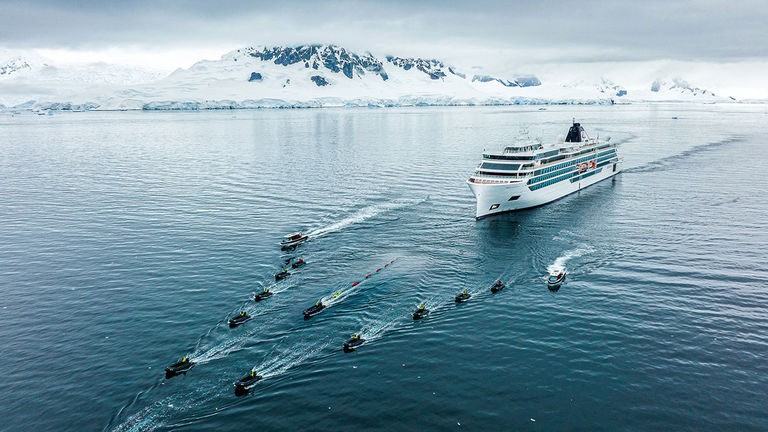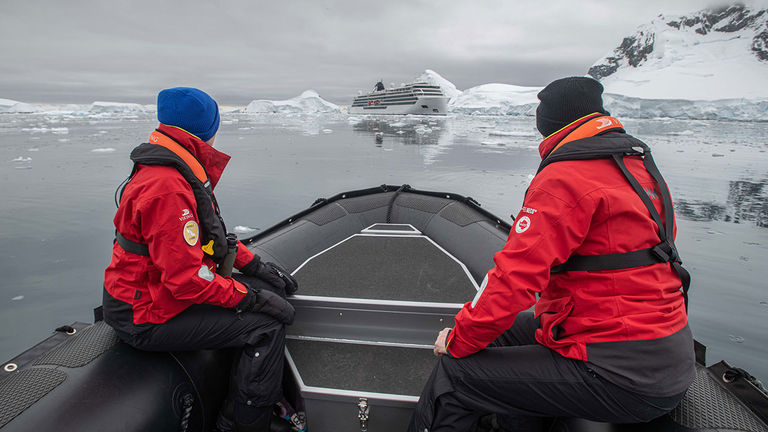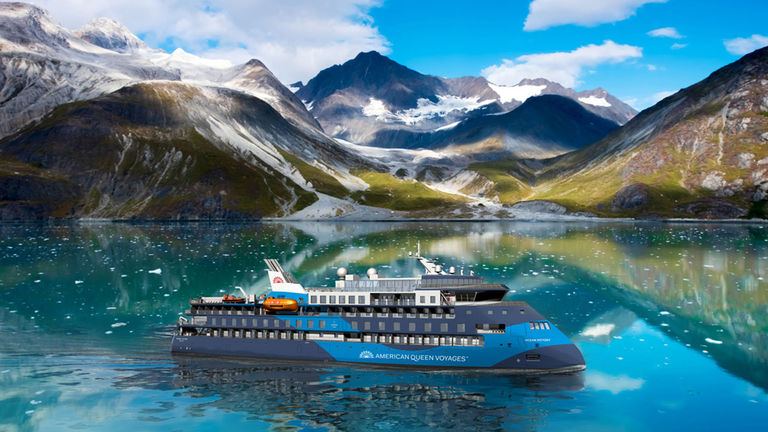Like theme park-goers waiting to board a ride at Disneyland, we eagerly awaited our vessel: the so-called Special Operations Boat (SOB). With an ease never before seen on an expedition ship, the SOB, propped up on individually motorized casters, coasted down its stable slipway to pick up its 12 passengers from Viking’s brand-new Viking Octantis.
Picture an aluminum-hulled Zodiac on steroids, complete with a dozen comfortable bucket seats, and you have conjured one of the two available SOBs housed in The Hangar, the ship’s massive, sheltered marina. Once we were strapped in, our SOB continued to slide out the back of the ship through a shell door as the slipway pitched to a steeper angle so we could float out. Next, we swiftly navigated the coastal waters of tropical St. Kitts in the Caribbean, before returning to the ship and reloading with equal aplomb.
Best of all, The Hangar and its pair of SOBs are accessible via elevator and gradual ramping floors, so anyone in any physical condition, wheelchair-bound or otherwise, can participate by boarding from a sturdy platform. This is something that’s not even possible when traditionally tendering while bobbing off the side of a typical cruise ship.
 Viking Octantis, a recently launched expedition vessel, offers travelers regular Zodiacs as well as two Special Operations Boats.
Viking Octantis, a recently launched expedition vessel, offers travelers regular Zodiacs as well as two Special Operations Boats.
Credit: 2022 Viking
Once onboard, each seat is supported on a shock absorber to further soften any rough seas, and if inclement weather presents itself, passengers can be shielded from rain and other elements. Make no mistake, these are very capable craft, sporting the agility and velocity of not only a Zodiac, but a Jet Ski.
Cutting-edge gear is the future of expedition cruising — making the Arctic, Antarctica and all remote destinations in between the poles marvelously accessible to everyone.
Here, we explore what next-generation ships such as Octantis — as well as other newly introduced or upcoming vessels — mean for the future of expedition cruising.
Size Matters
The first of the new breed of expedition vessels I experienced was Hurtigruten’s Roald Amundsen in 2019. The 528-guest ship displays similar Scandinavian interior design, but holds more people than the 378-guest Octantis. When in Antarctica, Hurtigruten limits its passenger numbers to 500 on Roald Amundsen and sister ship Fridtjof Nansen.
 Hurtigruten’s Roald Amundsen limits the number of passengers it takes to Antarctica due to rules set by the destination.
Hurtigruten’s Roald Amundsen limits the number of passengers it takes to Antarctica due to rules set by the destination.
Credit: 2022 HurtigrutenThese numbers matter to clients as they have an effect on the passenger-space ratio — the amount of ship volume available to each guest onboard. On Hurtigruten’s 20,889-ton ship (when at 528 guests), that ratio comes in at a tighter 39.56 versus 79.76 on Viking’s 30,150-ton ship.
That’s a substantial difference, but it accounts for double-decker spaces on Octantis such as The Hangar, its signature Explorers’ Lounge forward observation venue and The Aula, a new convertible glass-enclosed theater and lecture hall with expansive 270-degree views off the stern. In contrast, Hurtigruten’s public spaces are mainly single story, except for its impressive seven-deck atrium.
Of course, there are also plenty of expedition ships that carry fewer people than either of Hurtigruten’s or Viking’s latest, and they should be considered, too. After all, in Antarctica, only 100 guests can be onshore at one site at any given time, as regulated by the International Association of Antarctica Tour Operators.
For example, Aurora Expeditions’ Greg Mortimer and Sylvia Earle ships hold an average of 132 guests, ensuring all cruisers have ample opportunities on the icy continent.
Clients on bigger vessels must take turns getting off the ship and, therefore, spend less time on excursions than those on smaller ships. Super big ships have other issues to be aware of, as well.
Ships carrying more than 500 passengers on Antarctica sailings are not permitted to take guests onshore and are limited to cruising only — which is why Hurtigruten caps its passenger number at 500 on Antarctica sailings.
Oceanic Toys
When not onshore, travelers can also enjoy outings on Zodiacs, kayaks and, in some cases, submarines and helicopters that depart right from the ship. The amount and type of each available piece of equipment facilitates how effectively passenger counts are spread around Antarctica or elsewhere.
For example, Viking Octantis has 17 Zodiacs, plus 16 kayaks, two SOBs and a pair of six-passenger submarines, as well as two full-size tenders.
When previewing the ship in the Caribbean, the rigid inflatable boats were sparingly used, but the kayaks and submarines were deployed. Even though my sub dive was canceled due to bad weather, others who went enjoyed the experience despite seeing few fish within the limited 100 feet or so that they dove. In other regions, the contemporary Bathyspheres are capable of diving much farther, to a maximum depth of 1,000 feet.
 Viking Octantis offers 17 Zodiacs.
Viking Octantis offers 17 Zodiacs.
Credit: 2022 VikingSeabourn Cruise Line will also offer submarine dives when its expedition ships start setting sail this year, and Quark Expeditions and Scenic Luxury Cruises & Tours offer aerial tours via onboard helicopters (in addition to showcasing subs on Scenic Eclipse).
Smooth Operator
Another vital set of hardware on expedition ships — especially when navigating the notoriously rough seas of the Drake Passage to and from Antarctica — is that which supports overall stability.
Greg Mortimer is one of several nearly identical SunStone Ships chartered by companies such as Aurora — as well as Albatros Expeditions, American Queen Voyages (AQV) and Vantage Cruise Line — that features a trademarked Ulstein X-Bow. The inverted hull design smooths and quiets the ride in high waves and swells. Also sporting X-Bows are Lindblad Expeditions’ newly launched National Geographic Endurance and National Geographic Resolution.
 National Geographic Endurance and National Geographic Resolution both sport the Ulstein X-Bow.
National Geographic Endurance and National Geographic Resolution both sport the Ulstein X-Bow.
Credit: 2022 Lindblad ExpeditionsMeanwhile, Viking Octantis, with its own take on an inverted bow, emphasizes a U-tank and fin stabilizers. The dynamic ballast tank reduces rolling by almost 50%, but only when the ship is stationary or at low speed, and the fin varieties reduce rolling while at higher velocity. In practice, I would describe its motion profile as one that is relatively steady for a ship of its size, with a bit of yaw due to its extended length (which helps lessen pitching) and more of a roll still due to its narrow beam (width). But a greater draft and reduced height also minimize heeling.
Viking’s fin stabilizers, however, are not oversized. By comparison, Scenic’s newest ship, Eclipse, features zero-speed stabilizer fins that are 50% larger than standard ones, promising a reduction in rolling of more than 85%.
Another factor to consider is the hull’s ice rating, or its strength to traverse icy waters.
The vessels mentioned thus far are all capably classified as Polar Class 6 (PC6), the most common rating for passenger vessels.
One of the few to exceed that rating is Ponant’s unique Le Commandant-Charcot, a true icebreaker with a Polar Class 2 certification (the smaller the number, the stronger the ship), meaning it can go even deeper into ice sheets. The ship recently set a new world record, reaching the latitude of 78°44.3’ South — the closest geographic latitude to the South Pole in the Bay of Whales within the Ross Sea.
Genuine Scientific Exploration
Recognizing the importance of such an icebreaker to continued scientific enterprises, Ponant hosts researchers on the ship and features an onboard scientific lab where regional polar data is collected.
 The lab onboard Celebrity Flora
The lab onboard Celebrity Flora
Credit: 2022 Celebrity CruisesAn added layer of authentic scientific exploration has often been at the heart of expedition cruising. For example, Lindblad Expeditions partners with National Geographic, and Hurtigruten showcases a Science Center with a chemistry lab on Roald Amundsen, inviting collective discovery among guests and the expedition team.
Viking is now looking to elevate the concept even further with its own laboratory and extensive list of collaborations on Octantis and the upcoming Viking Polaris sister ship by welcoming guests to participate in many scientific activities.
The most popular is watching the ship launch weather balloons. In fact, Octantis is the only National Oceanic and Atmospheric Administration-designated weather observation station on a cruise ship, where from the top deck we witnessed a fascinating deployment in the Atlantic Ocean. After the balloon was launched, the expedition team shared the real-time data it was transmitting back to the ship at Expedition Central, the ship’s hub for interacting with the team.
 Hurtigruten’s Science Center features a chemistry lab.
Hurtigruten’s Science Center features a chemistry lab.
Credit: 2022 HurtigrutenWhen visiting The Laboratory itself, we were shown the ship’s FerryBoxes — a product from the Norwegian Institute for Water Research — that sample the waters in which the ship sails and measure their contents.
With microplastics becoming an ever-growing concern, passengers volunteered to help identify and count their presence in filtered samples using microscopes and other sophisticated gear. The data gathered is especially important for sampling purposes since the ship returns to the same destination weekly, monthly and annually.
Another Viking activity guests can join is preparing bait for BRUV (baited remote underwater video), which uses special camera rigs to study fish populations in various locales.
Location, Location, Location
Viking’s expedition ships predominantly visit Antarctica and the Great Lakes, along with a few Arctic departures and repositioning routes, while other lines frequent the North and South poles with jaunts in between. The Great Lakes are not a typical expedition destination, but for clients looking for local trips, they may fit the bill well. Ports include both U.S. and Canadian cities, as only Canada allows the use of the Norwegian-registered ship’s expedition equipment.
 Ocean Victory will sail expeditions closer to home.
Ocean Victory will sail expeditions closer to home.
Credit: 2022 American Queen VoyagesOther brands that are staying closer to home include AQV, which is deploying its new Ocean Victory to Alaska beginning this year.
Expedition cruising is likely to remain mostly in remote destinations, however. The Galapagos is another popular spot, with next-generation ships such as Celebrity Cruises’ Celebrity Flora and Silversea Cruises’ Silver Origin now exploring there.
And for clients leery of the Drake Passage, Scenic is one of several lines planning fly-cruises to Antarctica that bypass rough seas with flights to King George Island in the South Shetland Islands.
Fine Amenities
Gone are the days of aging industrial vessels repurposed for cruising with a veneer of luxury. Now, it’s difficult to go wrong with the creature comforts of any cruise line operating the latest ships, thanks to sizable staterooms and suites, fine dining, minimal but enjoyable entertainment and exceptional service. The luxury level of each, of course, varies from brand to brand, so it’s still the job of a travel advisor to funnel clients toward the one that best fits their preferences.
In any case, the next wave of expedition cruising and potential customers has most certainly arrived.